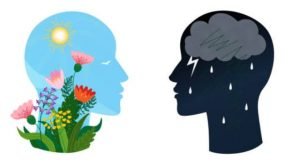
by admin | Jun 11, 2022 | Mental Health
COMMON PSYCHOLOGICAL DISORDERS
People commonly know psychological disorders as “Mental disorders” or “Psychiatric disorders,” which means conditions that affect how humans think and feel.
Psychological disorders are one of the factors that contribute largely to how humans live their daily lives. It can be influenced by environment, lifestyle, and genetics.
Most Common Psychological Disorders
As opposed to what many think, psychological disorder is no respecter of any age, gender, ethnic, and just like medical conditions, it can range from mild to severe. Its early stages might not be evident as the individual suffering from it might see it as normal mood swings. However, as it nears the severe stage, the individual might go into depression.
According to the Centers for disease control and prevention, over 50% of the world population suffers from one psychological disorder or the other.

One of the prevalent conditions around the World. Bipolar disorder is most common in the United States as over 2.6% of Americans suffer from it. The condition is associated with mood swings ranging from manic highs to depressive lows.
During manic highs, individuals suffering from this condition will be active and might not find it necessary to sleep. In the episodes of depressive lows, the individual will lose motivation to do anything and will most definitely experience a loss of energy.
Although the sole cause of the bipolar disorder is unknown, environment, genetics, and altered brain structure contribute largely to it. This condition can be lifelong, and treatments such as medication and psychotherapy can be of great help.

We all have our everyday fears; when stuck in traffic and it’s past resumption time at work, we fear getting a query from the boss. But, the anxiety disorder is far from the usual fear we experience.
This condition will make anyone suffering from it get extremely worried about every little thing they think about. It affects about 3% of Americans and causes them to have an unproductive day. Individuals suffering from anxiety disorder will most likely use antidepressants to reduce the level, but counseling tends to help as well.
- MAJOR DEPRESSIVE DISORDER

Commonly referred to as Clinical depression, it is another type of disorder that brings suicidal thoughts to individuals suffering from it. It lasts for months, and it reduces productiveness.
Clinical depression may cause an individual to become upset and violent to themselves. It is one of the prevalent conditions alongside Bipolar disorder, and it has been estimated to affect about 7% of Americans.
While the condition lasts a few months, it is necessary to seek the help of a medical professional as it might lead to suicide. Medication such as antidepressants might go a long way in curbing the condition.

This condition might seem normal at the mild stage, particularly for people who eat a lot and those that have very little appetite for food, but as it enters the severe stage, it becomes obvious. Eating disorders are of different types; they start with an obsession for food, body shape, and body weight.
Eating disorders include Anorexia nervosa, Bulimia nervosa, Binge eating disorder, rumination disorder, Restrictive food intake disorder, and Pica – pica is a rare condition that involves individuals craving substances that are not food items.
This condition might require the help of a medical professional as it could lead to death when left untreated.
- POST-TRAUMATIC STRESS DISORDER (PTSD)
PTSD is a type of psychological disorder that is prompted by traumatic occurrences. Failure to recover after experiencing natural disasters, war, and sexual molestation can trigger the condition.
Symptoms of this condition include frequent nightmares, flashbacks, startle response, lack of concentration, and avoiding the scenes where the event played out. PTSD might last for a few months or a few years and can be managed with medication and psychotherapy.
CONCLUSION
Psychological disorders can cause an individual to derail from his normal way of life and go into depression, affecting his lifestyle in general, but with medication, under the strict supervision of a medical professional and psychotherapy, such an individual can bounce back within a short time.

by admin | Jun 11, 2022 | Mental Health
Mental health awareness
Behind the Walls of the Mind –
A patient story of Complementary health support. Therapist note – In the light of mental health week, I thought I would share this heartfelt open patient story, looking at the possibilities of supportive complementary care for mental health issues. What do you think? Do you know any other success stories? Let’s share and get inspired.
Story
An issue of great complexity lurks behind your mind, one that is under study all the time. There are all kinds of people in this world, including those struggling with mental health, people of so-called “normal mind”, geniuses, and so forth. The mind has a nasty habit of taking us by surprise, letting us down, preventing us from achieving our goals, etc.
It may seem that whenever there is a battle with self and the brain there is no winning ticket. The truth is the mind holds the key to all areas of your body, but the central nervous system is the channel to the brain. Most of the time, when the brain is affected, it is a direct result of the central nervous system and spinal column. If the spinal column is injured or out of alignment, then the nervous system will be affected, which works its way to the brain. Trouble starts once the brain is hit, and often does not end until the source of the problem is found.
Thousands of individuals suffer from head injuries, neurological disorders, cognitive disorders, mental health issues and other diseases. As time goes by, the problems intensify.
I discovered in some research, studies, case studies, and so forth, that people who visited chiropractors tended to have better health than those who did not. In many cases, a patient’s condition improves when their doctor focuses on their spine, which is in direct contact with their brain.
Scientists are often looking for ways to understand the causes of mental illness, disease, and physical disabilities. It’s common for them to run in every direction, but sometimes the answer is right in front of them. Everybody has an opinion, a theory, and a guess, and many ignore the voices that call out with expertise and experience.
Chiropractors have sometimes faced some controversy regarding their services.
Despite the widespread belief that chiropractors only work with the body, experts realize that they are constantly dealing with the mind as well.
Let’s look at ADHD/ADD patients. Most of the time, symptoms of this diagnosis are caused by a part of the nervous system, spine, or brain. Most mental health professionals prescribe patients drugs, which only treat the symptoms, and are often causing other problems such as psychosis and schizophrenia.
Imagine if the MIND were treated without drugs, and natural herbs and spinal techniques were used. In the first place, there would be no or very few schizophrenia and psychosis patients.
Let’s take a look at Bipolar Disorder.

Chemical imbalances inevitably cause patients to suffer, so mental health professionals usually treat them with antidepressants, which may cause strokes, heart problems, early-onset changes in life and so forth.
What would happen if a specialist who knows the spine, nervous system, and brain treated the patient? In my personal experience, I know a woman with Bipolar disorder who has sought chiropractic care and is doing well overall, with the exception of her bad habits which she has exhibited for more than 20 years.
However, I know another bipolar patient who had no Chiropractic care, and she is the kind of person you may want to avoid if you can. She called me 18 times per day, threatened to commit suicide, and drove me absolutely nuts.
I am still in recovery. I visited a psychologist, psychiatrist, therapist, and doctor complaining of mental health symptoms.
As a result of chiropractic treatments, my symptoms decreased and I could cope better. In no way am I promoting anything, but to understand the mind you must consider the spine, the central nervous system, the brain, and many other factors. Often, the first thing you hear from counselors is a diagnosis; this can be a bad situation, as many play against your life to find an answer. It is not uncommon for professionals to change diagnoses once they see their diagnosis is off. Sadly, this cycle goes on and on, putting the patient at great risk.
Now as I have said I am a past sufferer of mental health and all I can say is, maybe it would be nice if we considered other alternative, safer, therapies before just jumping into the medicines and preconceptions of others. I would like to think that we all have freedom to choose. I am happy to say that today I am of happy and healthy body and mind and just wished to share my story in the hope it may help someone out there, anyone out there. If it helps but one person then it was worth to tell the story.
Therapist note – I think this is a very honest and heartfelt declaration and maybe it will or won’t help another person struggling with mental health to look at various options, whether that be conventional, allopathic ones or alternative, complementary, integrative, functional, naturopathic etc.
Either way mental health must not be overlooked, and I am sure if therapies are deemed safe then having options and extra support systems can only be good, and certainly seeing and hearing where people have successfully recovered from alternative therapies, in this case with the support of chiropractic treatment then that is truly heartwarming.

by admin | Jun 11, 2022 | Fitness
Barbells VS Dumbbells – Which One’s Better?
In the modern-day world, training your body usually happens in the gym, where you have a variety of dumbbell, barbell and machine exercises. In the context of free weight however, there has been one question floating around – What’s better, barbells or dumbbells?
If you’ve asked yourself this, keep reading because in this article we’ll underline the differences and benefits of both barbells and dumbbells, to help you create your perfect workout plan.
The Specifics
One of the main rules of weight training is to use a variety of equipment, angles and types of grip. The reason why this is important, is because even a slight change in the grip or angle of a given exercise, changes the specifics of that same exercise.
What this means is that a different type of equipment or a different angle/grip will shift the tension towards different muscles/zones of the worked muscle group. For instance, the flat bench press will mainly engage your mid and lower chest, while also engaging the triceps and shoulders.
However, an incline bench press will put more tension on the upper portion of the chest, along with increased tension for the shoulders. From this information, we can conclude that both barbells and dumbbells have their application and there really isn’t a “better” one. The point is to use each type of equipment for its designated purposes, in accordance with what your goal is.
The Benefits Of Barbells

Barbells are without a doubt one of the most effective ways to stimulate the musculature, whether we’re talking about muscle growth or training during the fat loss phase.
Here’s why:
- Barbells allow you to lift heavier weights
Because there is generally a fixed point between the working limbs, barbells allow you to lift heavier weights in general. This is also perhaps because of the fact that barbell exercises are more stabilized by nature, thus allowing your body to activate more of your fast-twitch muscle fibers.
You can check this for yourself – If you’re barbell bench pressing 80 kg for reps, odds are that you won’t be able to dumbbell press 40 kg on each hand as easily.
- Easier Realization Of Training Principles
When it comes to muscular development, there is one very important principle to consider. That is namely progressive overload, which implies that you should, overtime, progressively increase the demand upon the musculature (i.e increasing weight, reps, sets, etc.)
Because barbells allow you to lift heavier weights with more stability, increasing your workload is an easy task with barbells, as opposed to dumbbells Both of these benefits allow for greater working volume overall, which means that barbells are especially good during periods of gaining muscle mass.
The Benefits Of Dumbbells

Though barbells have a load of benefits when it comes to muscular development, that doesn’t mean dumbbells should be totally excluded.
Here are the main benefits of dumbbells:
- Bringing up weaker muscle groups
Because dumbbells inevitably make you use each side of your body separately, they can be one of your best picks when you’re trying to bring up your weaker side.
The individual load on each side simply doesn’t allow your stronger side to overtake the movement, thus creating sufficient stimulation on the side that creates asymmetry.
- Muscle Unit Activation
One of the most crucial factors when it comes to lifting heavy weights, is the muscle unit (muscle fiber) activation. With barbells, movements are generally fixed in a shorter range of motion, while dumbbells allow for greater movement of the arms. This therefore grants increased muscle activation, even on fundamental exercises like the bench press
Take Home Message
In the context of better overall development, there isn’t really a winner in the fight between barbells vs. dumbbells… Both have their benefits, which is why you should rather rely on a mix of the two, in your workout regimen.
Use barbells when you want to heavily target progressive overload and lift the heaviest weight possible. Use dumbbells when you want to bring up your weaker side and work more on joint stability, rather than maximum strength. Tell us your favorite barbell/dumbbell exercises in the comment section below!

by admin | Jun 11, 2022 | Yoga
what is kundalini yoga
Awakening through Kundalini Yoga
One of the most powerful forms of yoga is Kundalini Yoga. As one of the oldest Yoga styles, it is powerful enough that it was dubbed the mother of all yoga’s. It was first mentioned in the Upanishads, an ancient Sanskrit text, that was written between 1000 and 500 B.C. Yoga of this type awakens the Muladhara Chakra, located at the base of our spine. It is believed to be associated with the divine feminine.
Kundalini takes its name from a Sanskrit word which means coiled snake. In Kundalini Sadhana (practice) it is said that the energy lying dormant at the base of the spine, coiled up and tense, becomes uncoiled and rises up the spine through the body to become in alignment with the body’s chakras. The coiled energy resembles a serpent that has three and a half coils, resting at the bottom of the spine. The three coils in Kundalini Yoga are known as the three Gunas which are the Sattva, Rajas, Tamas. The VIkritis represent the half coil.
Kundalini Yoga is also known as the symbol of equality and power for both genders. The masculine power is known to be Siva (or Shiva) and Sakti (or Shakti) for the females. They become the elemental source of power and energy when they are united. We of course all carry, as human beings, elements of both within us, it is just that one or the other may be dominating. The union of Siva and Sakti occurs in the brain which gives us the sense of feeling and affection, energy and love. This means Kundalini Yoga is good to eliminate the feeling of sorrow, depression, anger and jealousy.
Kundalini Yoga gives rewards to Yogis who maintain unity, awareness and spiritual transformation. Some say that the Kundalini produces a hissing sound when it is awakened, like the sound of a serpent as it goes from the Muladhara Chakra to the Brahma Nadi (the channels through which energy and spiritual knowledge flows) and on to the Sahasrara Chakra (Crown chakra.)
In the year 1969, Yogi Bhajan introduced Kundalini Yoga and throughout the 70’s it spread through the Western world. It includes the practices of the common Mantra, meditation, chanting, breathing and the classic poses. This type of yoga actually focuses more on chanting and breathing. It does not really concentrate on the Kundalini Yoga Poses alone.
If you are curious about Kundalini Yoga, it is good to first understand the pathway it takes. One thing you need to understand is the connection of this yogic practice with the Nervous System and the Spinal Cord. These two are the main focus of Kundalini Yoga as it targets your Spinal Cord and the Nervous System.
The Nervous System as we all know is an important control centre of our body. It is responsible for the imaginations, thoughts, intelligence and memory that we have. The Nervous System is composed of the brain, the nerves and most especially the Spinal Cord which gives us posture and stand. The Spinal Cord is made up of very delicate nerves and tissues, which is why we need to take care of it. Kundalini Yoga is said to be one of the most appropriate practices for this. The overall purpose is to promote spiritual enlightenment.
Kundalini yoga can be practised at home or through online channels, but there is nothing quite like being in the presence of a practised yogi.
There are several science-backed and anecdotal benefits of Kundalini yoga – let’s look at them below:
- Stress and anxiety relief
- Improves cognitive function
- Boosts self-perception
- Spiritual enlightenment
- Calms the nervous system and promotes wellbeing
- Helps to awaken love and feelings
- Helps to cope with rejection, anger, jealousy and self esteem.
So why not try this special form of yoga for yourself, plug back into your spiritual side, and get the kundalini rising to boost your health and happiness.

by admin | Jun 11, 2022 | Health
Ashwagandha – The Wonder Root
Indian Ginseng, also known as “ashwagandha” has long been known for being a potent, non-toxic plant. In ayurvedic medicine, ashwagandha is used to treat and alleviate a variety of conditions, but can also be used to improve overall health and longevity in generally healthy people. In this article, we’ll give you insights on this herb, its contents and how to supplement with it.
Let’s get to it!
What Does Ashwagandha Contain?
The thing about ashwagandha is that it contains a flurry of potent, active ingredients, such as:
- Alkaloids
- Steroid lactones
- Vitaminoids
All of these have active effects on the central nervous system, immune system, cardiovascular and respiratory systems, as well as the lymphatic system.
What Is It Used For?
In ayurveda (healthy lifestyle indian system), ashwagandha is classified as a “rejuvenating” ingredient. It is expected to improve health on both a physical and mental level, but also help the body renew cells and fight over diseases and conditions.
Due to its wide variety of active compounds, ashwagandha is used in the treatment of many diseases that affect health. A fun fact is that the latin name of the root is “Withania Somnifera” and that basically means “sleep-inducing” when literally translated.
That is to say that Ashwagandha can have a positive effect on your stress levels, helping you lower them.
How Is Ashwagandha Used?
In traditional Indian medicine, all parts of the plant are used as a part of the home-made remedy. There are a variety of ways to prepare the brew and you can even do so by brewing it in milk, to get rid of the unpleasant smell.
The studies and research done for ashwagandha, make it one of the best-known, proven to work herbs. All these studies point us to the conclusion that ashwagandha is potent for:
- Anti-Inflammation
- Immune Modulation
- Anti-Stress
Besides all of that, ashwagandha is known for having anticancer substances in the root extract. In Ayurveda, the ashwagandha brew is expected to improve overall health, longevity and quality of life.
Are There Side Effects?
This plant is generally considered safe when supplemented with in proper amounts. There is only one single documented case of intoxication, where a young woman developed thyroid intoxication symptoms, after increasing her intake.
Needless to say, everything in excessive amounts may be harmful, so consider your intake and current state.
Who Shouldn’t Take It?
Due to the nature of its active ingredients, there are certain instances when supplementing with ashwagandha is not recommended.
Make sure to advise with your doctor if you fall into any of the categories below
- Pregnant/lactating women
- People with thyroid disease
- People that already use prescribed medicine
What’s The Recommended Dose?
Ashwagandha is a plant, used in many formulations of supplements, so odds are you will stumble upon some of those products. Your best bet is to use the recommended dosage on the product label.
Nevertheless, if you are only using the plant’s extract, you can use 250-600 mg a day. This is a dose that has been proven to alleviate cortisol levels by up to 30%.
Conclusion
It is a fact that your protein, fats and carbs play a major role in your health, but the truth is that there is much more than just calories and macronutrients.
Finding certain plants and learning how to use them for their active substances, may be one of the most nourishing things you can do for the body.
Ashwagandha is a perfect example for such a plant, as it is viable for stress management, recovery, inflammation and a variety of conditions and diseases.
Try this root and see the benefits for yourself!
Page 1 of 7112345...102030...»Last »


















